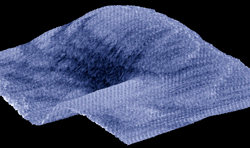The Perfect Rake

Imagine raking leaves in the yard and finding that–instead of a random pile–the leaves form perfectly ordered towers. In the 27 May print issue of PRL a team reports essentially that effect at the atomic scale. To investigate the process of mechanical wear, which affects both diesel engines and nanomachines, they carved a microscopic trench and found that the accumulated atomic debris had surprising order. The researchers also measured the energy that went into vibrating the crystal surface and into ripping out atoms. Experts say the work shows new details of the wear process and demonstrates a level of control that might be used for micromachining.
Researchers have scratched and imaged surfaces before using the probe tips of microscopes, but they haven’t been able to measure the forces involved. Ernst Meyer and his colleagues at the University of Basel in Switzerland built a type of scanning force microscope that measures both the vertical and horizontal forces on a probe tip as it moves across a surface, stretching and breaking bonds as it goes. While a few other labs have similar instruments, none of them had looked at mechanical wear at this level of detail.
Meyer and his colleagues first used the probe tip like a rake, scratching back and forth on a potassium bromide surface with enough force to dislodge atoms from the crystal. Then, using the same tip in a gentler imaging mode, they rescanned the surface in both scratched and unscratched areas. The team was surprised to see periodic order in the material piled up on the sides of the trench, suggesting that abrasion happens almost atom by atom, with ions coming off in pairs for this crystal.
The researchers wanted to learn what fraction of the scratching energy went into removing atoms–what they call wear–and what fraction went toward vibrating the lattice, or “friction.” They monitored the horizontal force as a tip was dragged along a line and then multiplied this force by the length of the path to get the total energy expended by the probe. The team then used images to count up the number of atoms torn from the surface. Because they knew the binding energy of atoms in the crystal, the Basel group could calculate the two separate contributions to scratching energy. According to their data, a third of the energy goes into wear. The energy data also confirmed that atoms are pulled from the surface in pairs.
The paper shows “a compelling result, one of only a handful of papers to take a serious look at wear on the atomic scale,” says Robert Carpick of the University of Wisconsin in Madison. John Pethica of the University of Oxford agrees, but notes that “what may really matter is what you can do controllably with large collections of atoms.” He thinks the Basel team has demonstrated a type of precise machining that might be developed and used to construct nanodevices.
–R. Mark Wilson
Mark Wilson is an Assistant Editor for .


